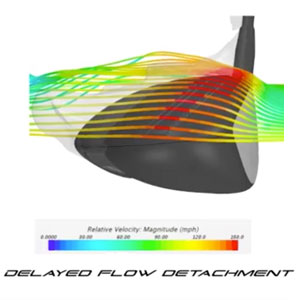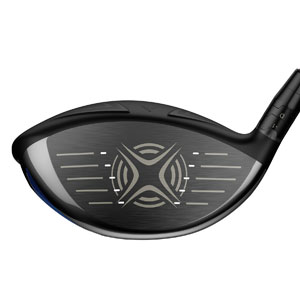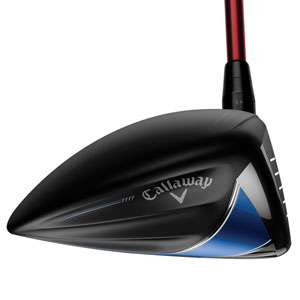Reviewing the Faster, More Forgiving Callaway XR16 Driver
01 Feb 2016
by Rusty Cage
see also: Equipment Reviews
SHARE:
When it comes to drivers, distance is
everything. And in order to design a driver
that’s longer, you’re going to need speed, lot’s
of speed. So when it came time for Callaway to
refresh their XR driver line, the company
challenged itself to rethink everything they
knew about aerodynamic head design to
release a club that’s faster than ever without
skimping on forgiveness.
Leveraging a long-standing relationship
they have with Boeing, Callaway put some
high-tech aerospace engineering concepts to
work on their new XR16 and XR16 Pro drivers,
redesigning the crowns to improve airflow and
reduce drag. But they didn’t stop there. The
new drivers also feature a completely re-
engineered next-generation R*MOTO face that
is lighter and thinner, helping to push the
center of gravity to a lower and deeper position
in the head.
“One of the things we realized first of all
is that we wanted to improve our
understanding of the airflow over the driver
during the downswing,” said Dr. Alan Hocknell,
Senior Vice President of R&D at Callaway. “We
decided it was time for us to step up our game
and partner with people who do this all the
time. The best aerodynamic experts in the
world work for the Boeing company and we
were fortunate enough to expand on a
relationship we had with them for some time.”

|
| Reduced
drag on the Callaway XR16
|
The woods team at Callaway worked
closely with the engineers at Boeing to study
how head shape influences airflow efficiency of
the club when it’s swung into impact. One of
the many challenges all equipment companies
face in driver design is maintaining a
reasonable level of forgiveness. In order to do
that, you want to maintain a relatively large
face-to-back dimension, said Hocknell. Of
course, that sort of design consideration tends
to run counter to the primary goal of reducing
drag and improving clubhead speed.
In order to conquer the problem,
Callaway and Boeing concentrated on the area
of the crown immediately behind the face of the
driver extending about a half inch or so
rearward. Their studies on airflow simulation
revealed that the design of that tiny area had
immense impact on drag.
 |
| The XR16 feature
faster R*MOTO
faces
|
“We wanted to create a situation where
we make the flow stay close to the crown
surface for a longer time as it moves from the
face towards the back,” said Hocknell.
The team took advantage of a feature
from last year’s XR driver, the Speed Step
Crown, refining its properties to improve
airflow. The new Speed Step (a pair of
uniformly-placed bars on the crown’s surface)
are ever so slightly raised and sit even closer to
the leading edge than ever before. Hocknell
noted that such a little change produced a
substantial result.
“It makes the air transition to turbulent
flow closest to the crown,” he said. “That
turbulent flow effectively sticks to the crown
better than other types of airflow and in doing
so it delays the flow detachment and we get
less drag.”
 |
|
Aerodynamic head shape powers
the XR16
|
Continuing with their mission to build a
faster and lighter driver, the XR16 models were
outfitted with a thinner and lighter R*MOTO
face. The weight that was saved in the new
construction was repositioned towards the back
of the head to increase the forgiveness of both
driver models. As for the head itself, the
chassis of the XR16 line is constructed from
new Titanium 8-1-1 material; it’s a strong and
lightweight alternative that gave engineers an
additional two grams to play with.
“It might seem like two grams isn’t a
whole lot but when you’re dealing with driver
design our woods team is constantly fighting
for fractions of a gram that can add up to whole
grams that they can put into useful places in
the head,” said Hocknell. “So a two-gram
savings gained by changing body material is
significant in our design world.”
Features at a glance:
- Aerodynamic head shape and a
Speed Step Crown allows Callaway to set the
standard in greater clubhead speed and more
distance.
- A faster R*MOTO face that is 19
percent thinner and nine grams lighter than the
pre-existing XR lineup of drivers. The savings in
weight was redistributed in the clubhead for
even more MOI.
- Designed with forgiveness in mind,
the crown has been stretched out with a bigger
footprint and the center of gravity has
repositioned lower and deeper to improve the
MOI over the X2 Hot and original XR drivers.
The XR16 driver ($349.99 MSRP) will be
available in three loft configurations (9, 10.5
and 13.5 degrees). The driver comes stock with
a Fujikura Speeder Evolution 565 shaft. By
comparison, the XR Pro model ($399.99 MSRP)
features a slightly lower spinning 450cc head.
The XR Pro comes in nine and 10.5 degree lofts
and ships with a tour-proven Fujikura Evolution
II TS 665 shaft. Both models feature Callaway’s
OptiFit adjustable hosel allowing you to adjust
the loft and lie to fit your swing. The new
drivers will be available in stores on January
29th.